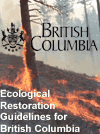ecological
integrity - the quality of a natural
unmanaged or managed ecosystem in which the natural ecological processes
are sustained, with genetic, species and ecosystem diversity assured
for the future.
ecological restoration -
the process of assisting the recovery and management of ecological
integrity. Ecological integrity includes a critical range of variability
in biodiversity, ecological processes and structures, regional and
historical context, and sustainable cultural practices. (definition
from the Society for Ecological Restoration)
ecological processes
- natural phenomena that determine the patterns
of ecosystems. Specifically, ecological processes such as natural
disturbance, hydrology, nutrient cycling, biotic interactions, population
dynamics, and evolution determine the species composition, habitat
structure, and ecological health of every site and landscape.
enhancement -
in the context of restoration this usually means to change a habitat
type or species to outside its natural range of variability.
exotic
species - organisms from outside the
bio-region or continent in question. The term exotic species are
often used synonymously with the term 'invasive species'. Invasive
species may or may not be exotic. Invasive species expand their
range and their coverage at the expense of other species, often
aiding by human activity. Many problem weedy plants are both invasive
and exotic.
extension
- in this context extension means to spread
information about the subject to others either through presentations
at conferences, preparation of papers or report.
extirpate -
to lose from the area. This refers to plants or animals that were
once found in the area but are no longer present. This is not to
be confused with extinction, where the species is gone from the
earth.
fine filter restoration
- restoration treatments for ecosystem components,
like individual species or specific habitat attributes. Fine filter
restoration is usually paired with the concept of coarse filter
restoration.
habitat (scale) restoration
- restoring specific structures or features
within ecosystems. This approach usually assumes that ecological
processes do not need restoring, and individual species will recover
once the appropriate habitat is restored.
keystone species -
a species that affects the survival and abundance of many other
species, and if removed will result in a relatively significant
shift in the composition of the ecological community.
landscape-level -
a watershed, or other natural biophysical (ecological) unit, within
a larger regional planning area. This term is most often used for
conservation or restoration planning, where large areas are needed
to plan for ecological integrity.
large woody debris
- a large tree part, conventionally a piece
greater than 10 cm in diameter and 1 m in length. This term most
often refers the tree parts that provide channel stability or create
fish habitat diversity in a stream channel. Similar tree parts on
land are usually called coarse woody debris.
mitigation
- the reduction of environmental harm or
impacts. Sometimes mitigation includes the concept of working to
offset overall negative impacts by creating habitat or undertaking
reclamation in one area to make up for losses in another.
natural disturbance
- periodic processes or events such as insect
outbreaks, fire, disease, flooding, windstorms and avalanches that
cause ecosystem change and renewal.
natural disturbance regime -
the historic patterns (frequency and extent) of fire, insects, wind,
landslides and other natural processes in an area.
natural disturbance pattern - the
landscape level effects of natural disturbance. For example, fire
may create a mosaic or pattern of forest stands of different ages.
Infrequent disturbance (such as in coastal forests) creates a pattern
of mostly older trees, with smaller areas of the landscape in younger
age classes.
natural range of variability -
the spectrum of ecosystem states and processes encountered over
a long time period.
overstory -
the layer of vegetation above the layer being considered such as
the herb layer provides an overstory to the moss layer and the shrub
layer is an overstory to the herb and moss layers
reclamation - to stabilize soil and
water on lands that have been damaged by industrial activity, and
return the land to some useful purpose.
reference ecosystem -
a less disturbed ecosystem similar to the one requiring restoration.
riparian -
an area of land adjacent to a stream, river, lake or wetland that
contains vegetation that, due to the presence of water, is distinctly
different from the vegetation of adjacent upland areas.
seral/ seral stage - a successional
stage of a plant community before it reaches its 'climax' community.
species (scale) restoration
- restoration where the focus is on an individual
species, rather than on ecosystem components or ecological processes.
Species scale restoration may include restoring habitat or population
size for important or rare species, and it also includes the removal
of problem species, like invasive exotics.
stand-level -
usually used in conjunction with landscape level,
stand level refers to the scale of forest management at which a
relatively homogeneous land unit can be managed under a single prescription,
or set of treatments, to meet well-defined objectives.
succession
- the sequence of changes a plant community
passes through before reaching its maximum possible development,
or 'climax community'.
umbrella species -
a species that requires large areas of habitat, and if managed for,
will encompass the needs of some other species as well.
understory
- the layer of plants below the overstory
such as the mosses under an overstory of herbaceous vegetation or
mosses, herbs and shrubs under an overstory of trees.
wildlife trees -
a wildlife tree is a standing live or dead tree with special characteristics
that provide valuable habitat for the conservation of wildlife.
Characteristics include large diameter and height for the site,
current use by wildlife, declining or dead condition, value as a
species, valuable location and relative scarcity.






